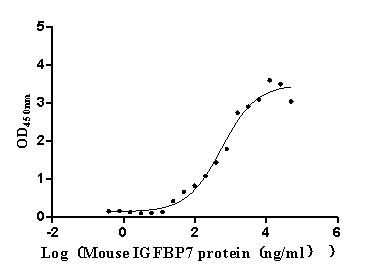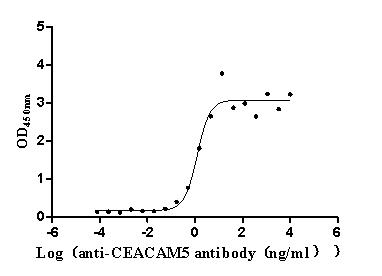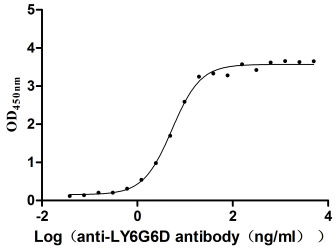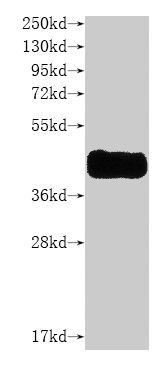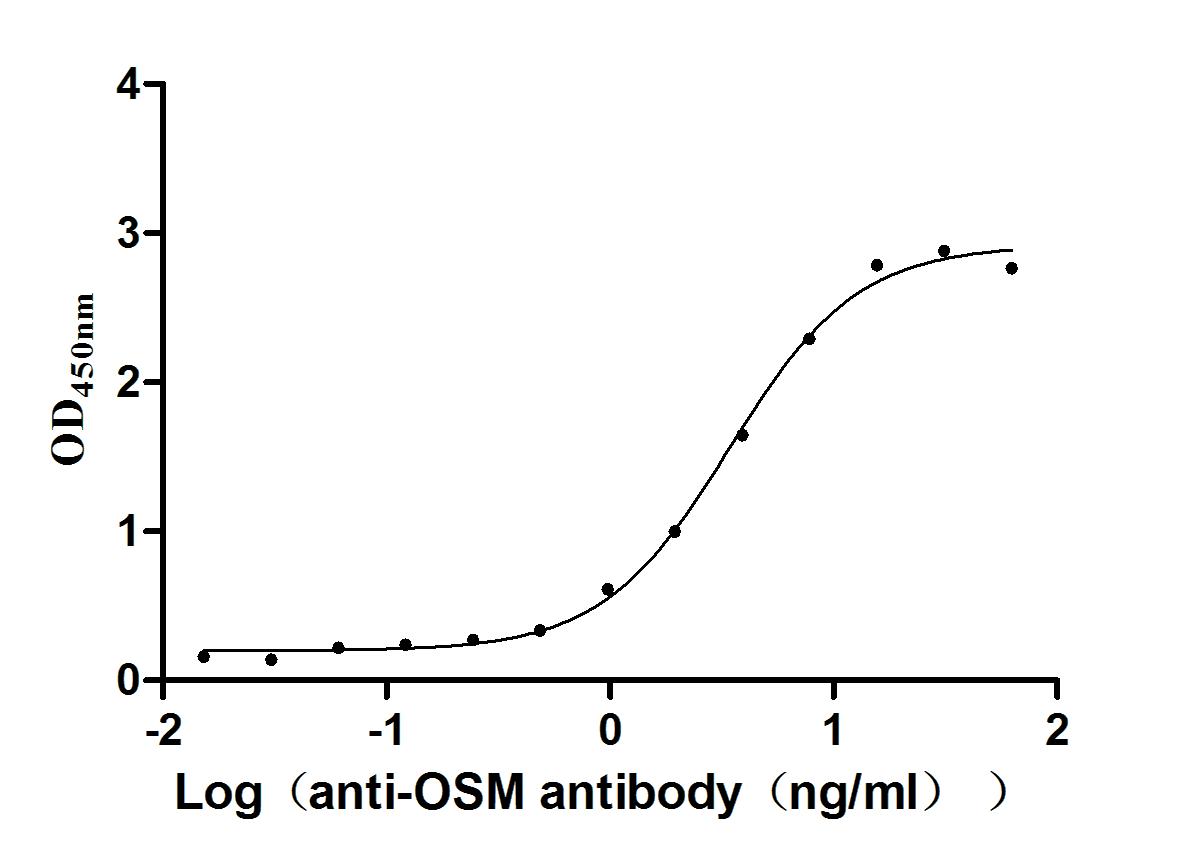Recombinant Chikungunya virus Structural polyprotein, partial
產(chǎn)品詳情
-
基因名:N/A
-
Uniprot No.:
-
別名:Structural polyprotein; p130
-
種屬:Chikungunya virus (strain S27-African prototype) (CHIKV)
-
蛋白長度:Partial
-
表達(dá)區(qū)域:810-1248
-
氨基酸序列YEHVTVIPNTVGVPYKTLVNRPGYSPMVLEMELLSVTLEPTLSLDYITCEYKTVIPSPYV KCCGTAECKDKNLPDYSCKVFTGVYPFMWGGAYCFCDAENTQLSEAHVEKSESCKTEFAS AYRAHTASASAKLRVLYQGNNITVTAYANGDHAVTVKDAKFIVGPMSSAWTPFDNKIVVY KGDVYNMDYPPFGAGRPGQFGDIQSRTPESKDVYANTQLVLQRPAAGTVHVPYSQAPSGF KYWLKERGASLQHTAPFGCQIATNPVRAMNCAVGNMPISIDIPDAAFTRVVDAPSLTDMS CEVPACTHSSDFGGVAIIKYAVSKKGKCAVHSMTNAVTIREAEIEVEGNSQLQISFSTAL ASAEFRVQVCSTQVHCAAECHPPKDHIVNYPASHTTLGVQDISATAMSWVQKITGGVGLV VAVAALILIVVLCVSFSRH
Note: The complete sequence may include tag sequence, target protein sequence, linker sequence and extra sequence that is translated with the protein sequence for the purpose(s) of secretion, stability, solubility, etc.
If the exact amino acid sequence of this recombinant protein is critical to your application, please explicitly request the full and complete sequence of this protein before ordering. -
蛋白標(biāo)簽:N-terminal 10xHis-tagged
-
產(chǎn)品提供形式:Liquid or Lyophilized powder Warning: in_array() expects parameter 2 to be array, null given in /www/web/cusabio_cn/public_html/caches/caches_template/default/content/show_product_protein.php on line 662
Note: We will preferentially ship the format that we have in stock, however, if you have any special requirement for the format, please remark your requirement when placing the order, we will prepare according to your demand. -
緩沖液:Lyophilized from Tris/PBS-based buffer, 6% Trehalose, pH 8.0
-
儲存條件:Store at -20°C/-80°C upon receipt, aliquoting is necessary for mutiple use. Avoid repeated freeze-thaw cycles.
-
保質(zhì)期:The shelf life is related to many factors, storage state, buffer ingredients, storage temperature and the stability of the protein itself.
Generally, the shelf life of liquid form is 6 months at -20°C/-80°C. The shelf life of lyophilized form is 12 months at -20°C/-80°C. -
貨期:Basically, we can dispatch the products out in 1-3 working days after receiving your orders. Delivery time may differ from different purchasing way or location, please kindly consult your local distributors for specific delivery time.Note: All of our proteins are default shipped with normal blue ice packs, if you request to ship with dry ice, please communicate with us in advance and extra fees will be charged.
-
注意事項(xiàng):Repeated freezing and thawing is not recommended. Store working aliquots at 4°C for up to one week.
-
Datasheet & COA:Please contact us to get it.
相關(guān)產(chǎn)品
靶點(diǎn)詳情
-
功能:Forms an icosahedral capsid with a T=4 symmetry composed of 240 copies of the capsid protein surrounded by a lipid membrane through which penetrate 80 spikes composed of trimers of E1-E2 heterodimers. The capsid protein binds to the viral RNA genome at a site adjacent to a ribosome binding site for viral genome translation following genome release. Possesses a protease activity that results in its autocatalytic cleavage from the nascent structural protein. Following its self-cleavage, the capsid protein transiently associates with ribosomes, and within several minutes the protein binds to viral RNA and rapidly assembles into icosahedric core particles. The resulting nucleocapsid eventually associates with the cytoplasmic domain of the spike glycoprotein E2 at the cell membrane, leading to budding and formation of mature virions. In case of infection, new virions attach to target cells and after clathrin-mediated endocytosis their membrane fuses with the host endosomal membrane. This leads to the release of the nucleocapsid into the cytoplasm, followed by an uncoating event necessary for the genomic RNA to become accessible. The uncoating might be triggered by the interaction of capsid proteins with ribosomes. Binding of ribosomes would release the genomic RNA since the same region is genomic RNA-binding and ribosome-binding. Specifically inhibits interleukin-1 receptor-associated kinase 1/IRAK1-dependent signaling during viral entry, representing a means by which the alphaviruses may evade innate immune detection and activation prior to viral gene expression. Degrades host cyclic GMP-AMP synthase (CGAS) thereby inhibiting the cGAS-STING pathway.; Provides the signal sequence for the translocation of the precursor of protein E3/E2 to the host endoplasmic reticulum. Furin-cleaved E3 remains associated with spike glycoprotein E1 and mediates pH protection of the latter during the transport via the secretory pathway. After virion release from the host cell, the assembly protein E3 is gradually released in the extracellular space.; Plays a role in viral attachment to target host cell, by binding to the cell receptor MXRA8. Synthesized as a p62 precursor which is processed by furin at the cell membrane just before virion budding, giving rise to E2-E1 heterodimer. The p62-E1 heterodimer is stable, whereas E2-E1 is unstable and dissociate at low pH. p62 is processed at the last step, presumably to avoid E1 fusion activation before its final export to cell surface. E2 C-terminus contains a transitory transmembrane that would be disrupted by palmitoylation, resulting in reorientation of the C-terminal tail from lumenal to cytoplasmic side. This step is critical since E2 C-terminus is involved in budding by interacting with capsid proteins. This release of E2 C-terminus in cytoplasm occurs lately in protein export, and precludes premature assembly of particles at the endoplasmic reticulum membrane.; Constitutive membrane protein involved in virus glycoprotein processing, cell permeabilization, and the budding of viral particles. Disrupts the calcium homeostasis of the cell, probably at the endoplasmic reticulum level. This leads to cytoplasmic calcium elevation. Because of its lipophilic properties, the 6K protein is postulated to influence the selection of lipids that interact with the transmembrane domains of the glycoproteins, which, in turn, affects the deformability of the bilayer required for the extreme curvature that occurs as budding proceeds. Present in low amount in virions, about 3% compared to viral glycoproteins.; Class II viral fusion protein. Fusion activity is inactive as long as E1 is bound to E2 in mature virion. After virus attachment to target cell and endocytosis, acidification of the endosome would induce dissociation of E1/E2 heterodimer and concomitant trimerization of the E1 subunits. This E1 trimer is fusion active, and promotes release of viral nucleocapsid in cytoplasm after endosome and viral membrane fusion. Efficient fusion requires the presence of cholesterol and sphingolipid in the target membrane. Fusion is optimal at levels of about 1 molecule of cholesterol per 2 molecules of phospholipids, and is specific for sterols containing a 3-beta-hydroxyl group.
-
基因功能參考文獻(xiàn):
- identifed amino acid residues required for nuclear export and, using replicon systems, showed that mutating the nuclear export sequence of CHIKV capsid protein blocks host protein access to the nucleus PMID: 29053568
- Structure reveals a chymotrypsin-like protease fold with a conserved hydrophobic pocket in capsid protein for interaction with the cytoplasmic tail of E2. PMID: 29306785
- Three novel 6K transmembrane protein-derived epitopes are presented by the common HLA class I molecule, HLA-A*0201. PMID: 29084215
- Domains A and B of E2 bound to all cells tested, independently of their permissiveness to Chikungunya Virus infection. PMID: 28114368
- There are five host proteins interact with E1 and three host proteins interact with E2. PMID: 25563600
- These studies demonstrate a correlation between Chikungunya virus tissue tropism and virus-induced pathology modulated by a single polymorphism in viral E2 protein. PMID: 25142598
- amino-acid changes in the E2 glycoprotein might affect viral infectivity by altering the interaction between CHIKV E1-226V and the cellular receptor on the midgut epithelial cells in Ae. aegypti but not in Aedes albopictus. PMID: 24681263
- study identified an amino acid polymorphism in the viral E2 attachment protein that influences utilization of glycosaminoglycans PMID: 24371059
- Studied the E2 gene of CHIKV circulating in Odisha from 2010 to 2011 by virus isolation, RT-PCR, phylogenetics and bioinformatics methods. Phylogenetic analyses revealed the circulation of Indian Ocean Lineage strains of ECSA genotype of CHIKV in Odisha. PMID: 23684629
- Novel variations in the glycoprotein E1 gene region were found in samples isolated from patients infected with Chikungunya virus. PMID: 22782121
- The E2-E166K substitution promotes a greater efficiency of Chikungunya virus replication in human myoblasts leading to severe apoptosis PMID: 22889614
- Western blot analysis showed that the E1 glycoprotein expression level and surface features in wild type and mutant substituted cells were similar. Cell fusion assay found that cells infected by CHIKV E1-H230A mutant baculovirus had low fusion activity. PMID: 22520648
- These results demonstrate that the acid sensitive region of E2 plays an important role in regulating particle generation. PMID: 22647698
- we undertook a comprehensive reverse genetic analysis of the effects of E2-L210Q in various CHIKV hosts PMID: 22174678
- The E1 gene sequence of the CHIKV was identical to those of CHIKV isolated from human chikungunya cases working in the affected area, and contained the A226V mutation. PMID: 21395419
- The authors analyzed various amino acid sequence requirements for the activity of Chikungunya virus capsid protease and found that amino acids outside the catalytic triads are important for the activity. PMID: 21087473
- crystal structures of the precursor p62-E1 heterodimer and of the mature E3-E2-E1 glycoprotein complexes PMID: 21124458
顯示更多
收起更多
-
亞細(xì)胞定位:[Capsid protein]: Virion. Host cytoplasm. Host cell membrane. Host nucleus.; [Spike glycoprotein E2]: Virion membrane; Single-pass type I membrane protein. Host cell membrane; Single-pass type I membrane protein.; [6K protein]: Host cell membrane; Multi-pass membrane protein. Virion membrane; Multi-pass membrane protein.; [Spike glycoprotein E1]: Virion membrane; Single-pass type I membrane protein. Host cell membrane; Single-pass type I membrane protein.
-
蛋白家族:Alphavirus structural polyprotein family
-
數(shù)據(jù)庫鏈接:
KEGG: vg:956308
Most popular with customers
-
Recombinant Human papillomavirus type 16 Protein E7 (E7) (Active)
Express system: E.coli
Species: Human papillomavirus type 16
-
Recombinant Human T-cell surface protein tactile (CD96), partial (Active)
Express system: Mammalian cell
Species: Homo sapiens (Human)
-
Recombinant Human HLA class II histocompatibility antigen gamma chain (CD74), partial (Active)
Express system: Mammalian cell
Species: Homo sapiens (Human)
-
Recombinant Mouse Complement component C1q receptor (Cd93), partial (Active)
Express system: Mammalian cell
Species: Mus musculus (Mouse)
-
Express system: Mammalian cell
Species: Homo sapiens (Human)
-
Recombinant Macaca fascicularis lymphocyte antigen 6 family member G6D (LY6G6D) (Active)
Express system: Yeast
Species: Macaca fascicularis (Crab-eating macaque) (Cynomolgus monkey)
-
Recombinant Human C-C chemokine receptor type 8 (CCR8)-VLPs (Active)
Express system: Mammalian cell
Species: Homo sapiens (Human)
-
Recombinant Human Oncostatin-M (OSM), partial (Active)
Express system: Mammalian cell
Species: Homo sapiens (Human)


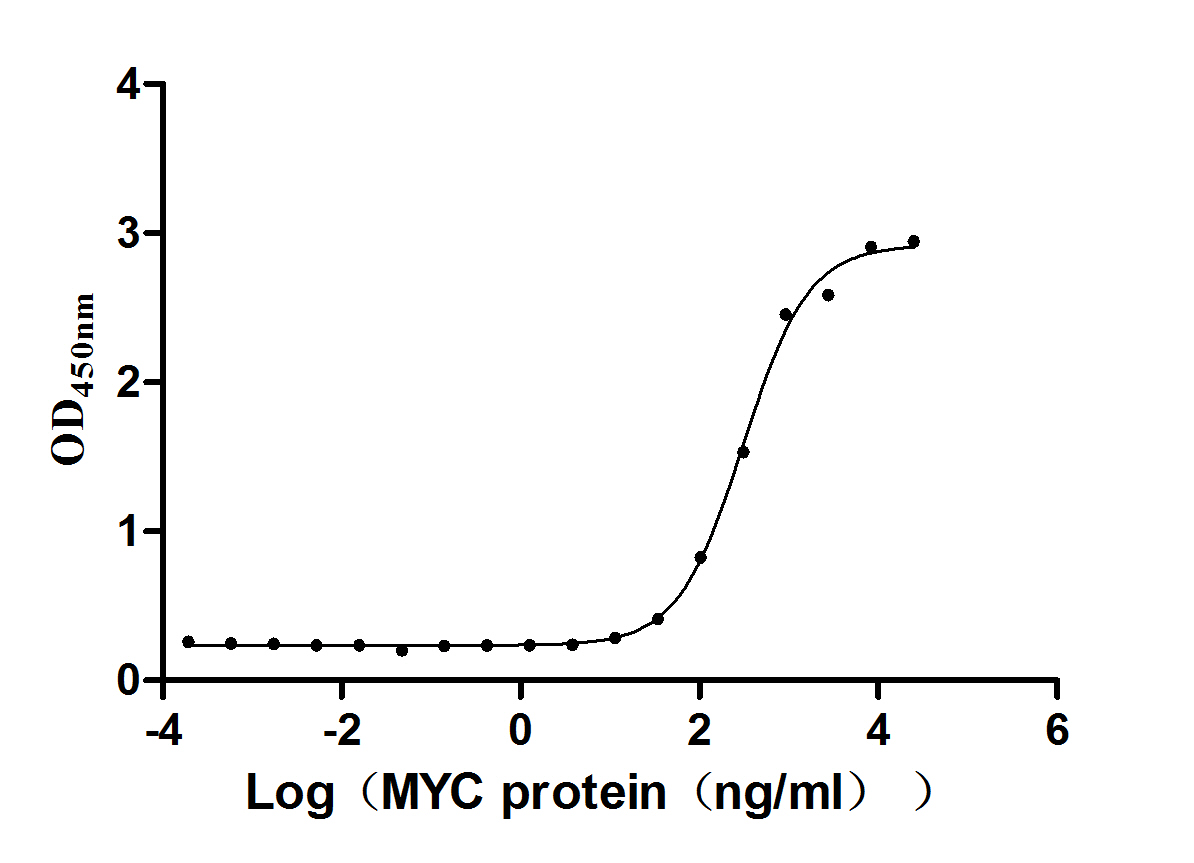
-AC1.jpg)
-AC1.jpg)
